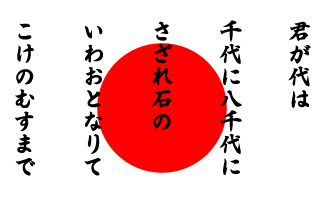 Flagge "Nationalflagge Japan
(150 x 90 cm)" bei fahnenversand.de kaufen.
Flagge "Nationalflagge Japan
(150 x 90 cm)" bei fahnenversand.de kaufen.
 Flagge "Nationalflagge Japan
(150 x 90 cm)" bei fahnenversand.de kaufen.
Flagge "Nationalflagge Japan
(150 x 90 cm)" bei fahnenversand.de kaufen.
 Flagge "Nationalflagge Japan
(250 x 150 cm)" bei fahnenversand.de kaufen.
Flagge "Nationalflagge Japan
(250 x 150 cm)" bei fahnenversand.de kaufen.
 Flagge "Nationalflagge Japan
(90 x 60 cm)" bei fahnenversand.de kaufen.
Flagge "Nationalflagge Japan
(90 x 60 cm)" bei fahnenversand.de kaufen.
 Flagge "Stockflaggen Japan
(45 x 30 cm)" bei fahnenversand.de kaufen.
Flagge "Stockflaggen Japan
(45 x 30 cm)" bei fahnenversand.de kaufen.
Last modified: 2025-05-03 by  zachary harden
zachary harden
Keywords: japan | sun (red) | rising sun | roundel: star |
Links: FOTW homepage |
search |
disclaimer and copyright |
write us |
mirrors
![[Japan]](../images/j/jp.gif)
image by Antonio Martins
Proportions: 2:3
![]()
ISO Code: JP JPN 392
FIPS 10-4 Code: JA
MARC Code: ja
IOC Code: JPN
External Links:
The symbol in the centre of the "Hi-no-maru" (日の丸, the Japanese national flag) is
the state "Mon" or emblem. It has been the state symbol of Japan for centuries.
The flag became the National Flag following the Meiji Restoration in 1868. It
never had rays.
Graham Bartram, 09 November 1998
While Album des pavillons [pay00] gives
the Pantone color as red 186C, I have a fabric sample on file which suggests the
use of Pantone 193C.
Christopher Southworth, 22 December 2005
From: Japan: an illustrated encyclopedia Vol. 2 (M-Z):
national flag
(kokki). The national flag of Japan has a crimson disc, symbolizing the sun, in the center of a white field. It is popularly known as the Hinomaru (literally, "sun disc"). It is said that at the time of the Mongol Invasions of Japan (1274 and 1281) the priest Nichiren presented a sun flag to the shogun. The Tokugawa shogunate (1603-1867) adopted the flag for its ships in the early 1600s. In the mid-19th century the shogunate decreed that all Japanese ships fly flags with the sun on a white field. In 1870 the Meiji government officially designated it for use on Japanese merchant and naval ships. It has never been officially designated as the national flag; however, it has become so by customary use. The "rising-sun" flag with 16 rays used by the former Japanese navy and by the present Maritime Self-Defense Forces is a military service flag and should not be confused with the national flag.
Beside a drawing of the flag is the following text:
M. Schmöger, 27 August 2001The design and proportions of Japan's national flag were fixed in 1870 by the Meiji government. The vertical to horizontal ratio was set at 2:3, the disc was to be placed at the exact center, and the diameter of the disc was to equal three-fifths of the vertical measurement of the flag.
The name of Nichiren means the sun and lotus in English (Nichi = Nihon
= the sun; Ren = lotus ) and the lotus is a typical symbol of Buddhism. That
is why he gave the sun (and lotus) to the Shogun who at that time was politically
opposed to the Emperor (who was a God in Shintoism). Nichiren is said the
greatest Buddhist in Japan because a majority of Japanese are not Shintoist
but Buddhist. The Nichiren was formed his organization which is now called
Soka-Gakkai whose political part is Komei-tou which is composed of the present
Japanese cabinet.
I think he believed his flag could help the Shogun, who had military power,
to save Japan and the people from Mongol Invasion. He could not find any reason
for him to give his flag to the Emperor who is believed the God and son of
the Sun but who had no ability to defeat Mongolian.
Nozomi Kariyasu, 29 August 2001
Nichiren's purpose was to motivate the political powers to abandon the more popular Buddhist sects and to accept the Lotus Sutra as the one sure way to save Japan. His was a religious and philosophical movement, not a political one. At the same time he issued to the government a treatise entitled "Rissho Ankoku Ron" which predicted great disaster for Japan should they not retreat from the heretical (popular) Buddhist sects and accept his teachings.
Bruce Ward, 2 September 2001
At http://www1.jca.apc.org/anti-hinokimi/archive/chronology/senzen/ (a Japanese language webpage) there is a chronology of the history of Japanese flags, anthems, et cetera, based on contemporary official documents.
A few interesting things:
Miles Li, 30 November 2006
The protocol manual for the
London 2012 Olympics (Flags and Anthems Manual
London 2012 [loc12]) provides recommendations
for national flag designs. Each
NOC was sent an image of the flag,
including the PMS shades, for their approval by LOCOG. Once this was obtained, LOCOG produced
a 60 x 90 cm version of the flag for further approval. So, while these specs may
not be the official, government, version of each flag, they are certainly what
the NOC believed the flag to be.
For Japan: PMS 032 red.
Ian Sumner, 10 October 2012
![[Flag in decree 57, 1870]](../images/j/jp~1870.gif)
The Prime Minister's Proclamation No. 57 issued on January 27 in the 3rd Year of Meiji (1870):
Regulations of Merchant Ship (abridged)1. The national flag:
This shall not be removed and even a ferryboat shall keep it hoisted.
Hoist it at 8 a.m. every morning and haul it down at sunset every evening. In case of non-hoisting of the national flag it is customary of the international law that no plea is justified it treated as pirates.2. The dimensions of the national flag:
The ratio of the hoist and fly 7:10.
The diameter of the disc: three fifths of the hoist length of the flag locating in the center.Regulated as above for strict observances.
Ministry of Home Affairs
Ministry of Foreign Affairs
Source: Japanese National flag - Japanese National symbol Marks.
Tokyo: Kokki Kyokai (National Flag Association), circa 1970. p. 3.
Jos Poels, 18 January 1996
Posted at https://groups.io/g/flags/files/J/JP/jp-Japanese-Flag-Laws.1870-2005.pdf is "Japanese flag Laws from the official gazette1870-2005", dated 2021-05-30, by Nozomi Kariyasu (15 December 2023): "I have listed all of the flag-related laws from the official bulletins and laws and regulations from the establishment of the Meiji government to the end of World War II discovered in the National Diet Library Parliamentary Archives."
The date of adoption for the naval jack was on October 3rd, 1870 (Meiji 3) and it was from Prime Minister's
Proclamation No. 651. The law shows the flag ratio was 2x3 and also has the sun-disc as 3/5th of
the hoist of the flag. The position of the sun-disc is placed in the center. This pattern is the exact same as the current national flag.
Zachary Harden, 16 October 2017

image by Zachary Harden, 22 February 2008
Recently, I discovered a Japanese flag imposed with writing on it on
Yahoo Auctions. The auction
mentions the text imprinted on the flag is the lyrics of Kimi ga Yo, the Japanese
national anthem. I have seen this as patches and stickers, but this is
the first time I have actually seen it on cloth.
Zachary Harden, 22 February 2008

image by Zachary Harden, 28 August 2017







